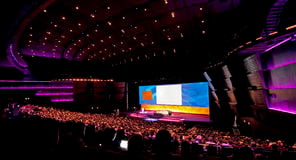
Conferences are as diverse in their structure and purpose as the speakers on the platform. They can be regional, national, or even international. These meetings can be internal, external, and sales, client or annual conferences or leadership retreats.
Once you are done determining your meetings' purpose, structure, and theme, then comes selecting the perfect speaker for your event.
Putting together an event is like putting together a puzzle. Its a lot easier to find all the correct pieces when you know the theme or the overall picture you are trying to create.
FIND THE RIGHT SPEAKER FOR YOU
The types of speakers that you hire and retain for your event are:
- Plenary speakers
- Keynote speakers
- Emcee
- Guest Speakers
Each type of speaker adds value to meetings but for different motives. Read on and find out the difference between them.
Plenary speaker and motivational keynote speakers are often used interchangeably. Both speak to a larger audience with a generic message but relevant enough for the entire group.
PLENARY SPEAKERS
A plenary speaker is usually an industry expert or is sometimes from within the organization. Plenary speakers play a critical role in events to shapes the minds of the attendees about the future. If your industry goes through incredible change, you will need a thought leader or an industry expert plenary speaker to drive people in the right direction.
With the help of a plenary speaker, you can straighten out the facts and create structure, predictability, and clarity. A plenary speaker can be from within an organization; it can be an executive director, CEO, finance director, and more.
A plenary speaker usually doesn't make public speaking their primary job. It's just something they are called on to give a specific message at a specific time. However, some plenary speakers are hired for specific reasons. I have regularly seen David Suzuki from the Nature of Things act as a plenary speaker at conferences. His message heavily focuses on the work we need to do to support the environment for future generations. It's technical yet relevant for a general audience.
If the plenary speaker is relevant and a little animated, things can work out quite well. However, if the message is a bit too heavy, it can easily backfire and send listeners back to their hotel rooms for a quick afternoon nap, trust us on this.
KEYNOTE SPEAKERS
A keynote speaker's job is to inspire people, encourage the audience's participation and appreciate their attendance at an event. A keynote speaker can be funny, motivational, have name recognition, and can even be an industry expert.
The event is later broken down into workshops or breakout sessions after the keynote. To raise interest as well as boost attendance, a plenary speaker or keynote needs to drive home a message that's relevant to the broader audience.
Most conferences hire multiple top keynote speakers and place them as opening or closing keynote speaker. The event's tone is set by an opening keynote speaker, whether it's humour, motivation, or industry trends. The event ends on a high note, and the closing keynote speaker plays that part.
Strategically placed, keynote speakers can boost energy, create awareness, add levity and keep the event engaging.
EMCEE
The Emcee performs the role of the Master of Ceremonies. They act as the host of the staged event. A great emcee will kick off the event, introduce the program theme and key players. They will seamlessly transition between the keynote speaker and guest speakers. The emcee will advise people the tactical parts of the event like where break out sessions are located, any program changes, lunch directions, fire safety regulations and more.
The Emcee should bring energy and personality an event while still keeping a personalized feel. They want to make sure all guests and speakers feel welcome and included.
GUEST SPEAKERS
Once you've hired your plenary and keynote speakers now, you need to fill in the rest of your schedule. The rest of the event includes break out sessions.
Usually, three or four back to back break out sessions happen simultaneously after the opening keynote. People get to choose which sessions they want to attend.
Draw on guest speakers on specific topics relevant to the audience. Look for industry leaders who want to present new technologies, government policy changes, new leadership styles, change in the industry, etc. Frequent event attendees like industry leaders are often a good choice. Already having a rapport with the audience, they will be a great draw. Long-standing industry leaders can give you a broader, more relevant perspective and inspire people with their career path.
I often also see hired guest speakers on topics like GEN Y engagement, emotional intelligence, coaching, conflict management skills, public speaking etc.
Break out sessions usually have a smaller audience because the whole group breaks off to see separate guest speakers. Thus they can be more interactive, do activities, and audience members ask questions etc.
Guest speakers usually have more in-depth content and are more interactive than a keynote speaker. Break out sessions involve smaller audiences and are often slightly longer. They are designed to be more interactive and delve into specific content relevant to certain subgroups within an audience.
Well, there you have it, now you know the difference between a keynote speaker, guest speaker, MC and plenary speakers.
Create your event with enthusiasm and pride. Think about audience members and what they have been struggling with. Remember we only get together on a large scale like this a couple of times a year. Thus, there will be core ideas that need to be discussed. Start with your theme and build these needed elements into the agenda.

